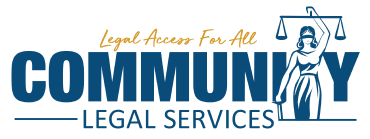The Advocate’s Voice: Be Your Own Voice in Court
The Bill of Rights grants many of the rights Americans hold most dear: the freedom of speech, the right to assemble, and protection from unlawful searches. But, even though it is equally vital, Americans often overlook one right: the promise of due process.
Bridging the Justice Gap
Due process guarantees the right to fair treatment in court, but what happens if you cannot afford a lawyer to ensure that right is protected? Unfortunately, the cost of legal representation makes it unattainable for many Americans, leaving them to face the justice system alone. This disparity, known as the justice gap, reflects the growing divide between people’s legal needs and the resources available to solve them.
Community Legal Services seeks to fill the justice gap by offering free legal assistance for those who qualify. But its mission goes beyond direct representation. CLS equips individuals with knowledge to advocate for themselves through accessible legal representation. A new part of this initiative is Litigation Corner, a CLS web series educating and empowering people on their rights in the courtroom. In the first episode, John Martino, CLS’ Director of Litigation, offers practical guidance for how individuals can represent themselves effectively when legal counsel is not an option.
Presenting Your Case: Practical Tips for Self-Representation
If you cannot access legal counsel, you still have rights—and tools. Martino emphasizes two key elements for courtroom success: knowledge and preparation.
Martino highlights how to approach evidentiary hearings—proceedings where the court examines and evaluates the evidence presented by each side. Not all hearings are evidentiary, so it is crucial to understand the type of hearing you are attending to prepare accordingly.
To present a clear picture of a case for a judge or jury, it is important to understand what type of evidence you have, how it is relevant to the case at hand, and what this piece of evidence proves. Here are some of Martino’s tips for preparing evidence:
- Photographs: These can serve as powerful physical evidence—if they are clear, relevant, and accurately reflect the situation. Always print out all photographs before going to court. If the photograph is not printed out, the court will admit whatever digital device (phone, computer, etc.) contains the picture into evidence.
- Text messages and emails: These serve as written proof of what has been said in the past. Print out all communication and organize messages chronologically to help the judge or jury follow the sequence of events. Again, failing to print this evidence may result in the court temporarily seizing your device as evidence. You do not want your phone to get in the way of justice!
- Know what your evidence proves: Understand the purpose behind each piece of evidence. What does it demonstrate? How does it relate to your case? Being able to answer these questions helps you tell a compelling and organized story in court.
Before you go to court, take time to learn the purpose of the hearing and how to present your case persuasively.
Community Legal Services is here to help you gain the skills and confidence you need to stand up and be heard. Watch the first episode of Litigation Corner to learn how to successfully represent yourself in court from John Martino!
Bridge the justice gap and donate to Community Legal Services today!
https://www.legalaccessforall.org/donate/
Written by: Joseph Gage
